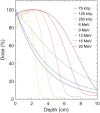Film measurements of kilovoltage x-ray percentage depth doses for different energies and field sizes
- PMID: 40424360
- PMCID: PMC12341685
- DOI: 10.1093/bjr/tqaf107
Film measurements of kilovoltage x-ray percentage depth doses for different energies and field sizes
Abstract
Objectives: Kilovoltage x-ray therapy, which includes superficial x-rays and orthovoltage x-rays, is particularly suited for treatments near the skin surface. Radiation dose deposition at depth is typically characterized by percentage depth dose (PDD) curves. However, PDD data are difficult to obtain in kilovoltage x-ray therapy, hence clinics often rely on British Journal of Radiology Supplement 25 (BJR-25) archival data. This study measured PDD for different energies and field sizes on the Xstrahl 300 kilovoltage x-ray therapy unit for comparison with BJR-25 data.
Methods: We irradiated EBT3 film in water using different energy and field size combinations, then, compared the acquired PDD curves with BJR-25 data. We used 75, 125, and 250 kVp beams, for 10 × 10 cm2 open field, 4 × 4 cm2 closed-ended square applicator, and open-ended circular applicators of 1.5, 2.0, 2.8, and 4.7 cm diameter.
Results: PDD for different energies and field sizes on the Xstrahl 300 kilovoltage x-ray therapy unit agreed well with BJR-25 data. The average difference between measured and BJR-25 data was -0.3 ± 1.8%; 85.9% of the individual local differences were within ±3%, 94.8% within ±4%, and 99.5% within ±5%.
Conclusions: The PDD curves presented here, together with BJR-25 data, can serve as useful comparison datasets for the commissioning of kilovoltage x-ray machines.
Advances in knowledge: Our film-based measurement technique provides high spatial resolution PDD datapoints for a modern kilovoltage x-ray unit, adding to the limited published data in the kilovoltage energy range.
Keywords: kilovoltage x-ray; orthovoltage; percentage depth dose; superficial.
© The Author(s) 2025. Published by Oxford University Press on behalf of the British Institute of Radiology.
Conflict of interest statement
None declared.
Figures





Similar articles
-
Radiotherapy class-solution to correct an energy-dependent optically stimulated luminescence film dosimeter.Med Phys. 2025 Jul;52(7):e17920. doi: 10.1002/mp.17920. Epub 2025 Jun 4. Med Phys. 2025. PMID: 40468156
-
Machine characterization and central axis depth dose data of a superficial x-ray radiotherapy unit.Biomed Phys Eng Express. 2022 Dec 8;9(1). doi: 10.1088/2057-1976/aca611. Biomed Phys Eng Express. 2022. PMID: 36541531
-
Characterization of a new low-dose and low-energy Gafchromic film LD-V1.J Appl Clin Med Phys. 2024 Dec;25(12):e14531. doi: 10.1002/acm2.14531. Epub 2024 Sep 11. J Appl Clin Med Phys. 2024. PMID: 39259853 Free PMC article.
-
The effect of sample site and collection procedure on identification of SARS-CoV-2 infection.Cochrane Database Syst Rev. 2024 Dec 16;12(12):CD014780. doi: 10.1002/14651858.CD014780. Cochrane Database Syst Rev. 2024. PMID: 39679851 Free PMC article.
-
Magnetic resonance perfusion for differentiating low-grade from high-grade gliomas at first presentation.Cochrane Database Syst Rev. 2018 Jan 22;1(1):CD011551. doi: 10.1002/14651858.CD011551.pub2. Cochrane Database Syst Rev. 2018. PMID: 29357120 Free PMC article.
References
-
- Cheraghi N, Cognetta A, Goldberg D. Radiation therapy in dermatology: non-melanoma skin cancer. J Drugs Dermatol. 2017;16:464-469. - PubMed
-
- Likhacheva A, Awan M, Barker CA, et al. Definitive and postoperative radiation therapy for basal and squamous cell cancers of the skin: executive summary of an American society for radiation oncology clinical practice guideline. Pract Radiat Oncol. 2020;10:8-20. 10.1016/j.prro.2019.10.014 - DOI - PubMed
MeSH terms
LinkOut - more resources
Full Text Sources

